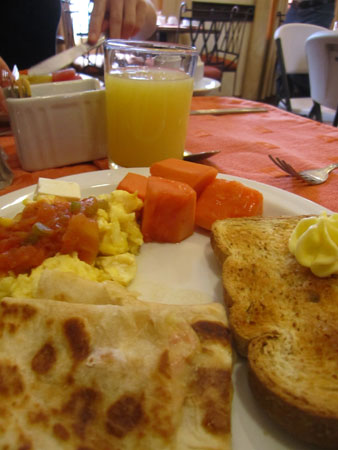 The down side of a group vacation with around 20 people is that you need a bus to get everyone to any site, which means everyone has to be on board and ready to go. This means getting up at an unreasonable hour for us night owls. However, El Salvador is 2 hours behind EST, and a small country, so it wasn’t as early as it could’ve been. The hotel’s breakfast changed daily, today including little ham and cheese quesadillas.
The down side of a group vacation with around 20 people is that you need a bus to get everyone to any site, which means everyone has to be on board and ready to go. This means getting up at an unreasonable hour for us night owls. However, El Salvador is 2 hours behind EST, and a small country, so it wasn’t as early as it could’ve been. The hotel’s breakfast changed daily, today including little ham and cheese quesadillas.
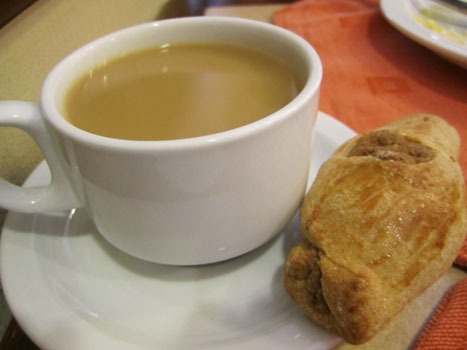 Despite half the country growing some of the best coffee in the world, both our guide books warned us that the locals don’t get the best beans (they’re exported) and prefer it watery. The hotel’s offering required a couple of cups just to get my eyes open. But the cacophony of racket that was the extended family definitely woke me up, whether I was ready to do so or not.
Despite half the country growing some of the best coffee in the world, both our guide books warned us that the locals don’t get the best beans (they’re exported) and prefer it watery. The hotel’s offering required a couple of cups just to get my eyes open. But the cacophony of racket that was the extended family definitely woke me up, whether I was ready to do so or not.
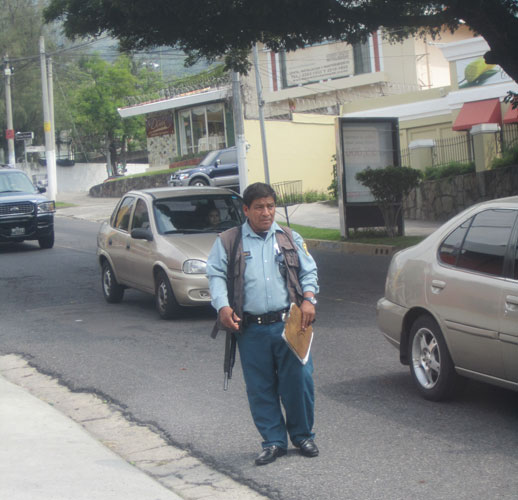 Pile onto the bus, wave goodbye to the hotel guard, and we’re off.
Pile onto the bus, wave goodbye to the hotel guard, and we’re off.
The countryside of El Salvador is lush. It’s difficult to understand how a country so green can be so poor, but there is evidence of their challenging economy everywhere. Tin shacks as homes, struggling papusa stands, unfinished building projects – basically the same stuff that’s happening in the U.S., just further down on the economic ladder.
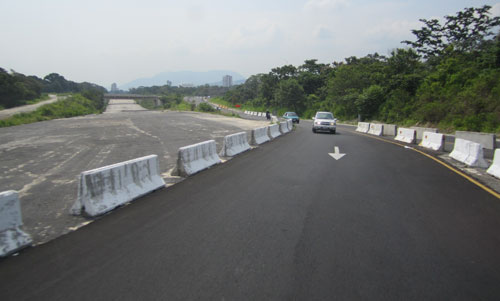 We cruise across the volcano where the highway has yet to be repaired from the last time it was damaged by an eruption, perhaps the one in 1986. The road criss-crosses the old highway around the mountain until you see fields of black rock – old lava flows.
We cruise across the volcano where the highway has yet to be repaired from the last time it was damaged by an eruption, perhaps the one in 1986. The road criss-crosses the old highway around the mountain until you see fields of black rock – old lava flows.
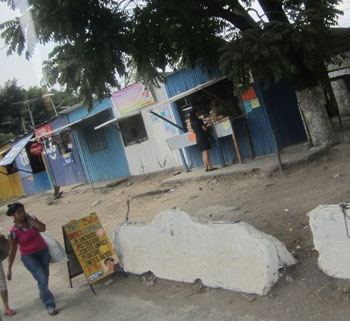 Out into the jungle and through small towns where every other shed seems to be a papusa stand. They’re cheap food for the masses but we wondered how many of them could possibly stay in business. Several locals told us that the recession in the U.S. has hit El Salvador hard. Immigrants to the U.S. used to send back large sums of money but these days they have no work, so the country has lost a large revenue stream.
Out into the jungle and through small towns where every other shed seems to be a papusa stand. They’re cheap food for the masses but we wondered how many of them could possibly stay in business. Several locals told us that the recession in the U.S. has hit El Salvador hard. Immigrants to the U.S. used to send back large sums of money but these days they have no work, so the country has lost a large revenue stream.
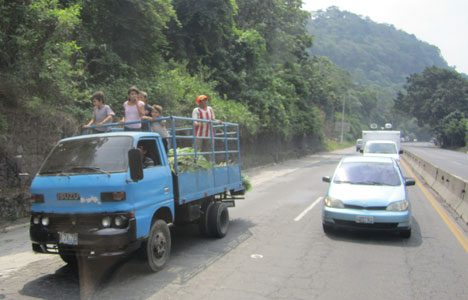
Everywhere you travel you’ll see people riding in the backs of trucks, sometimes holding down cargo. We spotted children, ladies in high heels, laborers, all surfing along with expertise.
Today’s expedition was to some volcanoes. As we climbed higher and higher, the views of the country improved. Sugarcane fields gave way to coffee plantations and forest. The bus pulled over to let us gawk at a view of Lago de Coatepeque, a volcanic lake we’d be visiting later in the day. Check out the view. Note: some browsers automatically resize the image. Put your cursor over the picture to zoom in.
Up and up we climbed until the walls around houses were made entirely of volcanic rock.
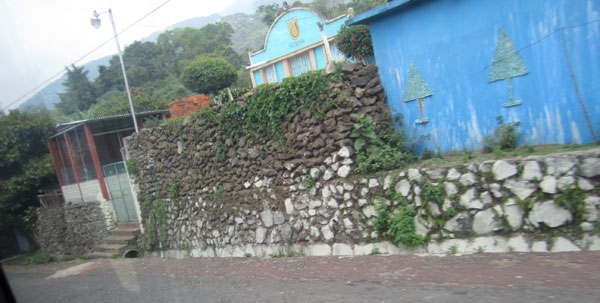
The volcano’s peak grew closer, glimpsed through the trees that provide shade and windbreaks for the coffee plants.
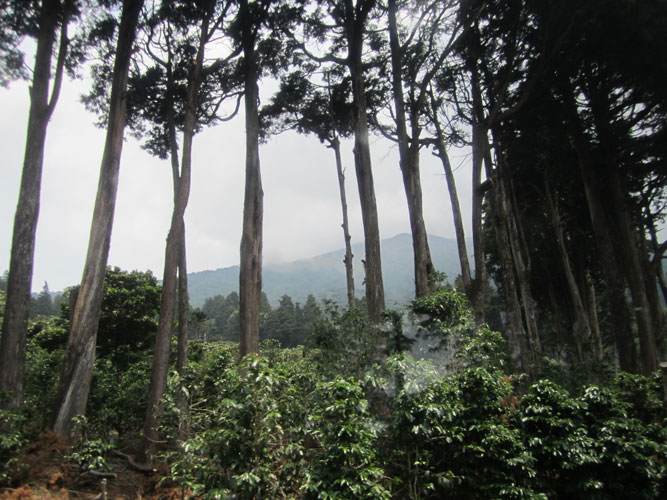
Countless switchbacks later, past tin shacks and soccer fields perched on cliffs, we round a bend into a national park where a playground has a view that is randomly nothing but gray clouds, randomly the volcano next door.
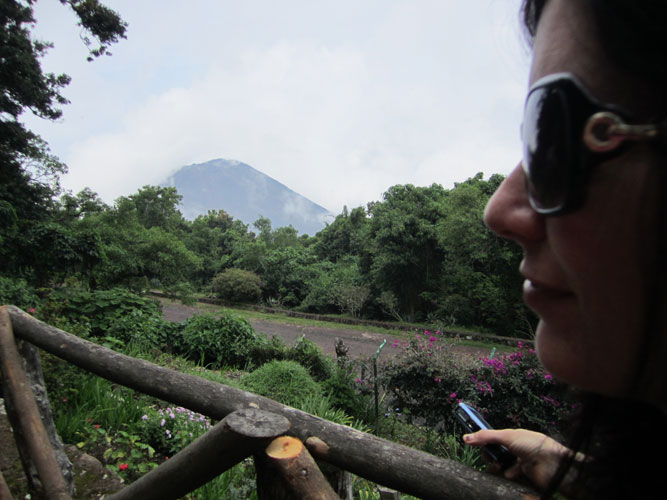
That’s Izalco, which erupted last in 1966. The clouds drifting across it looked as if they were coming from the rim of the volcano several times, giving us pause.
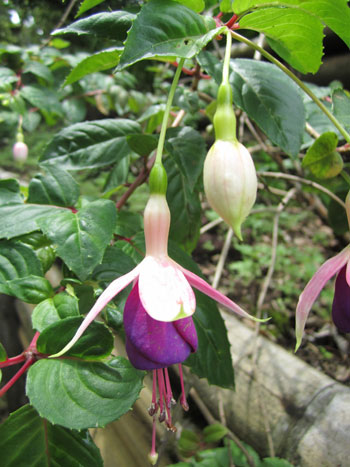 We hired a guide to give us a short tour of the jungle around the park, perhaps a half hour walk around the rim of an overgrown volcano. The trail has a few hills but nothing compared to hiking the neighboring Izalco, from what we’d been told. Alas, few in our group were up for the 4 hour trek down and up Izalco, so we had to make due with the shorter, forested hike.
We hired a guide to give us a short tour of the jungle around the park, perhaps a half hour walk around the rim of an overgrown volcano. The trail has a few hills but nothing compared to hiking the neighboring Izalco, from what we’d been told. Alas, few in our group were up for the 4 hour trek down and up Izalco, so we had to make due with the shorter, forested hike.
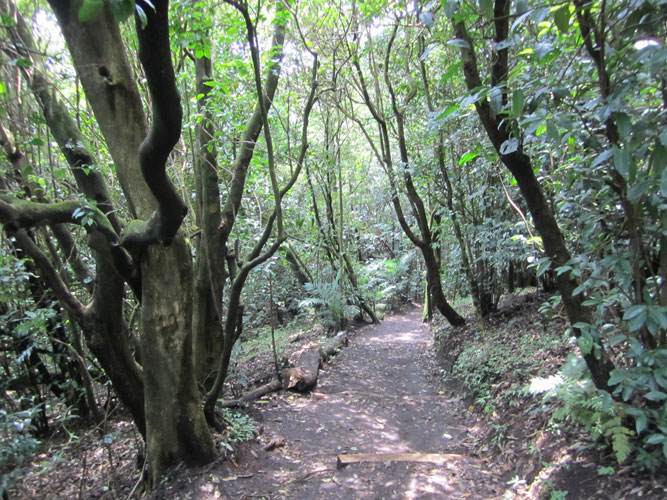
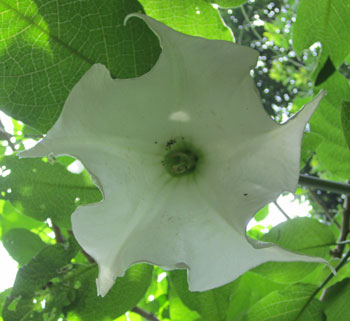 We circled back to the entrance of a former hotel built in the 60’s with a view of then-erupting Izalco. Unfortunately, Izalco stopped erupting the same year they completed the hotel and the place was abandoned. You can catch a glimpse of a few cabins through the trees and a few rarely-sed picnic tables throughout the park.
We circled back to the entrance of a former hotel built in the 60’s with a view of then-erupting Izalco. Unfortunately, Izalco stopped erupting the same year they completed the hotel and the place was abandoned. You can catch a glimpse of a few cabins through the trees and a few rarely-sed picnic tables throughout the park.
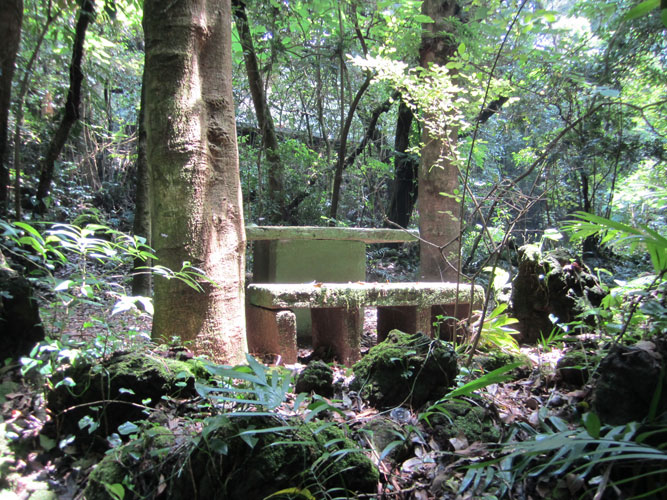
The hotel itself was very retro-futuristic with jutting concrete angles and nifty 60’s decor. I would’ve been happy to stay, live eruption or no, but alas the jungle is taking it back.
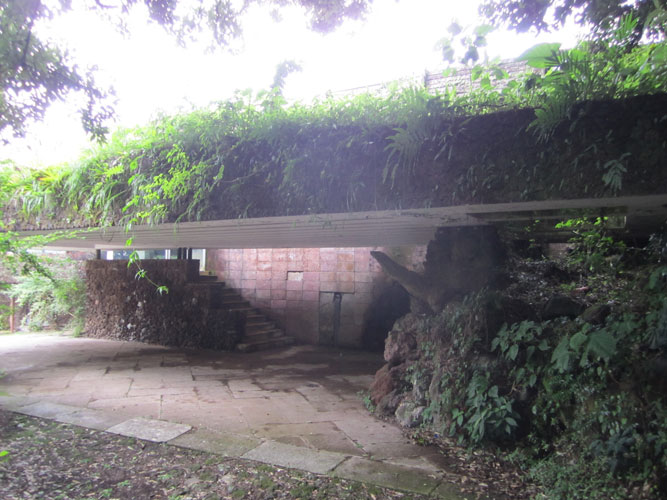
Must’ve been a heck of a view during the eruptions, however!
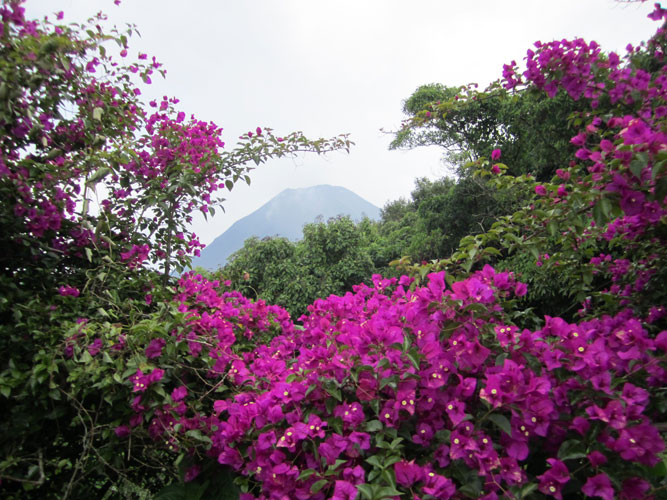
The former pool or fountain now hosts art students sketching the crumbling building, as well as the occasional lizard.
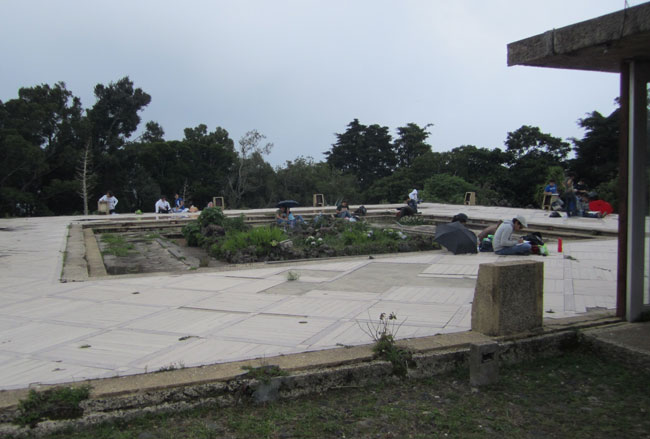
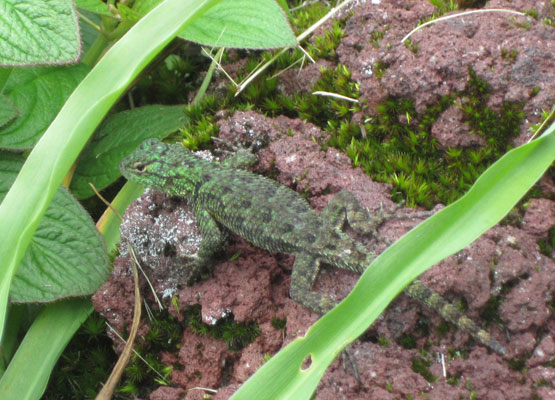
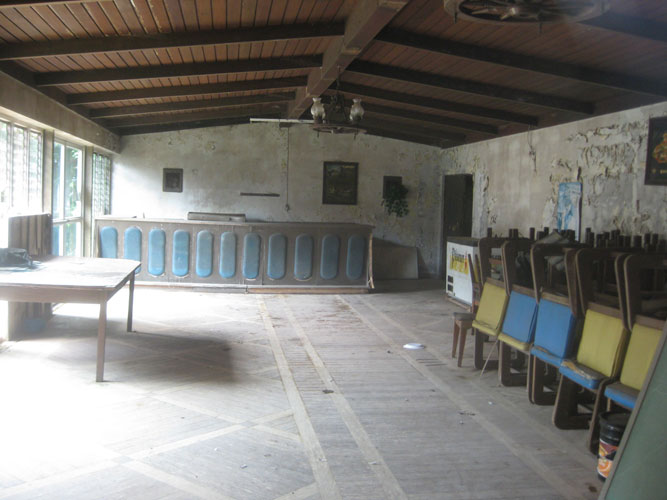
One of the rooms is used as a gift shop with a small variety of leather and wood trinkets for sale.
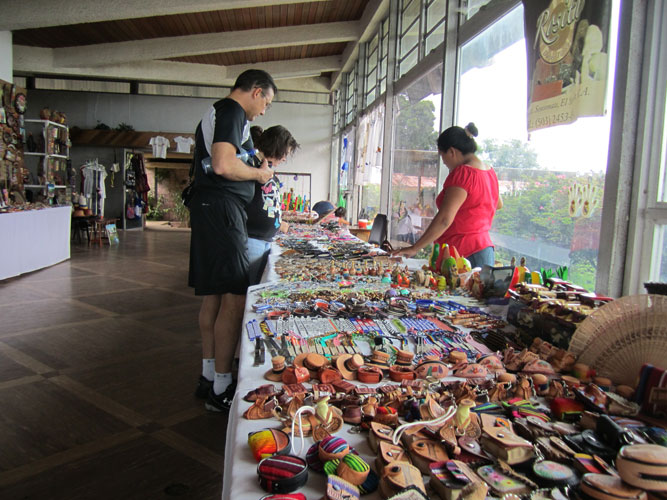
Most of the gang. My brother wasn’t in country yet, and the elder Crusans stayed in town.
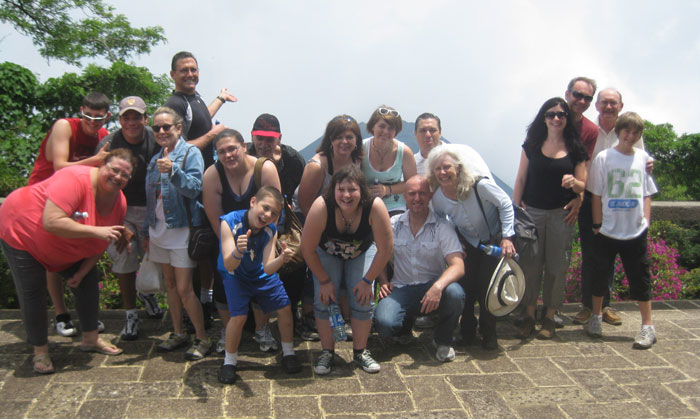
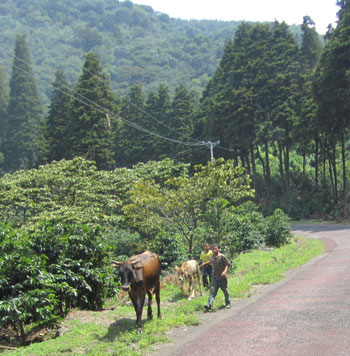 Back down the mountain we came, spotting countless cows grazing by the road. I think we saw one or two actual cow pastures the entire trip, but cows were grazing roadside everywhere we went.
Back down the mountain we came, spotting countless cows grazing by the road. I think we saw one or two actual cow pastures the entire trip, but cows were grazing roadside everywhere we went.
Down and down we went, the lake growing ever closer until we were passing lakehouse gates with flowering trees and gutters full of mangoes.

Around to a restaurant, a series of docks right on the water – perfect.
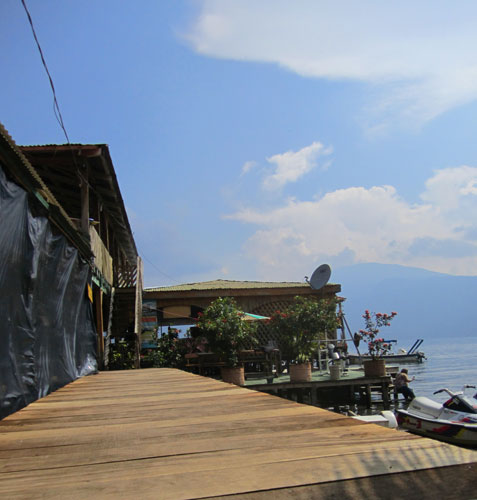
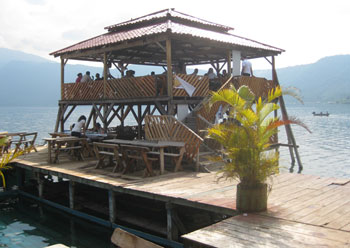 As soon as I saw the second story deck I said, “Oh, you can bet I’m gonna jump off that!”
As soon as I saw the second story deck I said, “Oh, you can bet I’m gonna jump off that!”
The water was crystal clear, a beautiful contrast to the purple/blue/green rim around us. Check out the view! Note: some browsers automatically resize the image. Put your cursor over the picture to zoom in.
We got a table on the second story and ordered. We watched a guy snorkeling next to the dock, spearfishing for what might have been our lunch. A few beers later, I slipped over the rail and hit the water. Cool and refreshing, I paddled back to the dock only to find She Who Shall Not Be Named had beaten me into the water, thanks to some extremely slippery steps at the edge of the dock. Her tumble earned her a bruise, as well as First Into the Volcano bragging rights!
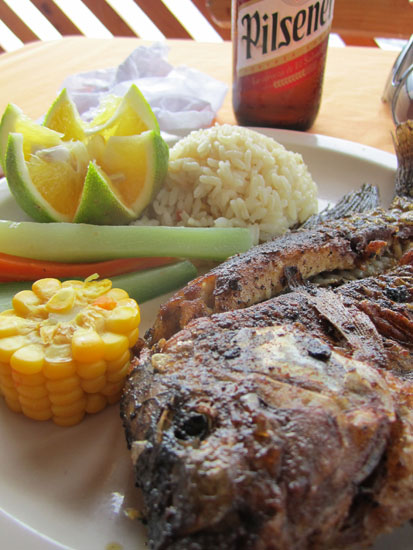 Lunch arrived. I opted for the fish, fried with a salty crust. Bony but damn good.
Lunch arrived. I opted for the fish, fried with a salty crust. Bony but damn good.
She Who Shall Not Be Named went with Churasco, a thin steak. Very tasty.
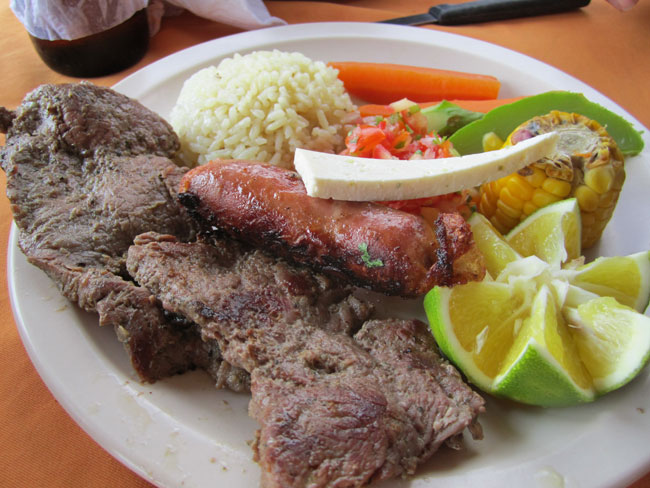
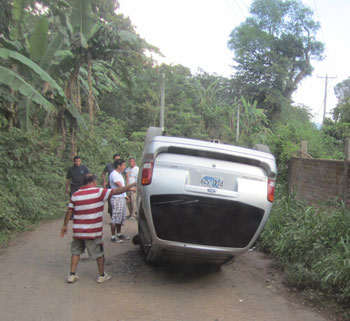 After another dip it was time to ride on, back up the winding dirt road past an SUV that had managed to land on its roof. We wondered for a moment if it had tumbled down from a switchback above but there wasn’t enough damage to it, or the forest, to have taken that shortcut. Somehow they’d gotten fast enough to roll it on the narrow, rough road. I was impressed.
After another dip it was time to ride on, back up the winding dirt road past an SUV that had managed to land on its roof. We wondered for a moment if it had tumbled down from a switchback above but there wasn’t enough damage to it, or the forest, to have taken that shortcut. Somehow they’d gotten fast enough to roll it on the narrow, rough road. I was impressed.
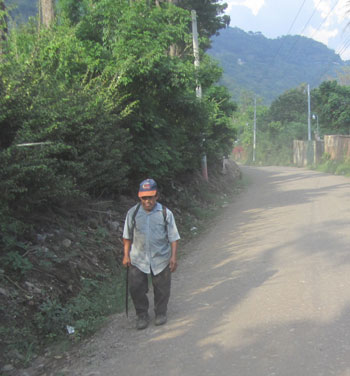 In addition to cows, the other thing you’ll spot along the road in El Salvador is a guy with a machete. It seems half the populace is carrying one, either the traditional straight model or one curved like a scythe. They’re so ubiquitous they offer them with decorative sheathes and blades at souvenir shops.
In addition to cows, the other thing you’ll spot along the road in El Salvador is a guy with a machete. It seems half the populace is carrying one, either the traditional straight model or one curved like a scythe. They’re so ubiquitous they offer them with decorative sheathes and blades at souvenir shops.
Back through towns where the median becomes a spontaneous market during rush hour where locals clamor for shoes, t shirts and, of course, papusas.
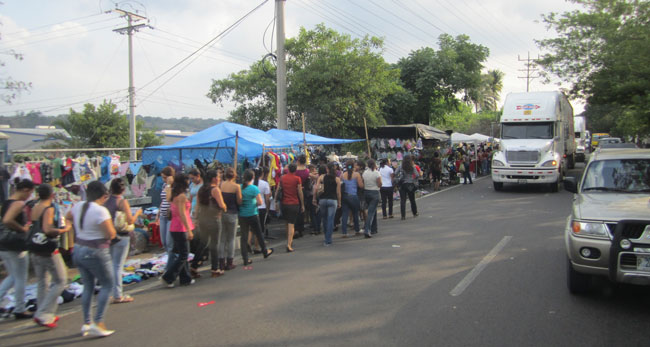
Rather than return to the hotel, we were taken directly to the next family function, visiting a well-to-do home on the opposite side of San Salvador. The view from the hillside lawn was worth the stop alone!
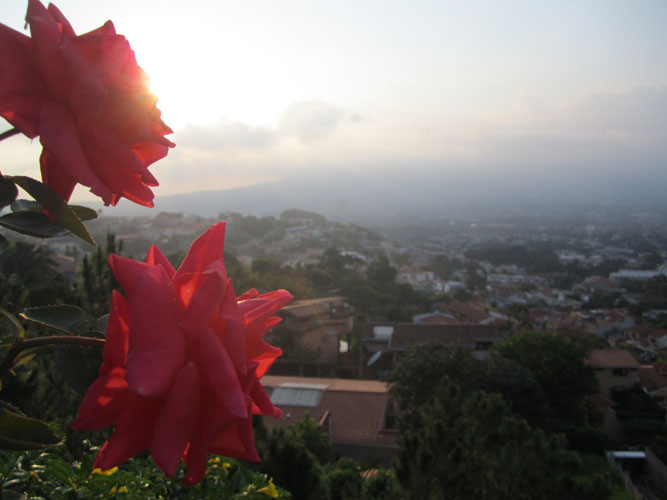
Need more? How about another panorama? Note: some browsers blah blah blah.
Despite little notice, our hosts let us linger long into the night. The city turned into a field of lights, pretty, as all cities are at night.
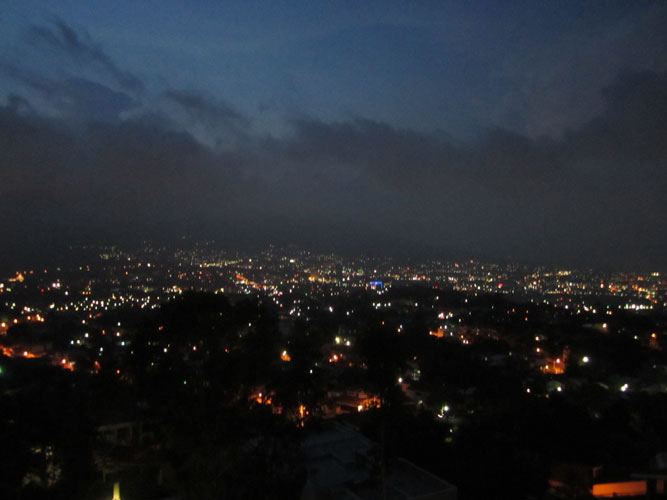
If 20 gringos showed up at my door with little notice the best they could hope for would be some lawn chairs and a glass of water. Instead, we were treated to another fine meal of Salvadoran food – papusas, tamales, some delicious slaw (the name of which escapes me), some empanada-like thing (name unknown), mini sandwiches – the works.
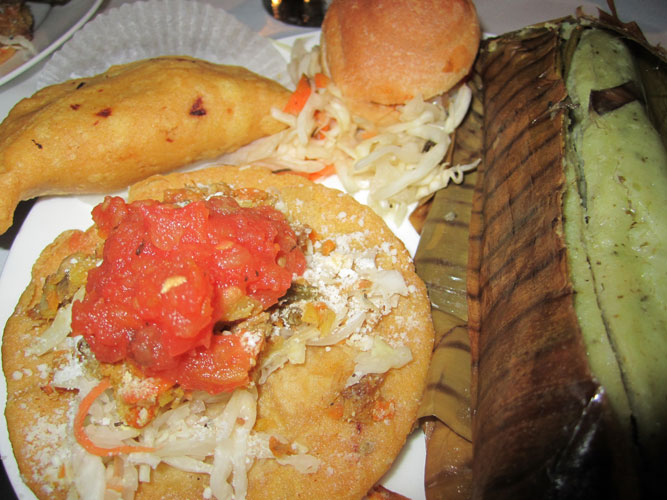
We arrived at the hotel stuffed and tired, only to find my brother waiting on us. I think we probably trekked back to the 660 bar up the block but 10 days later it’s all a happy blur.
Next episode – another volcano, zip-lining through a coffee plantation, and the big To Do.